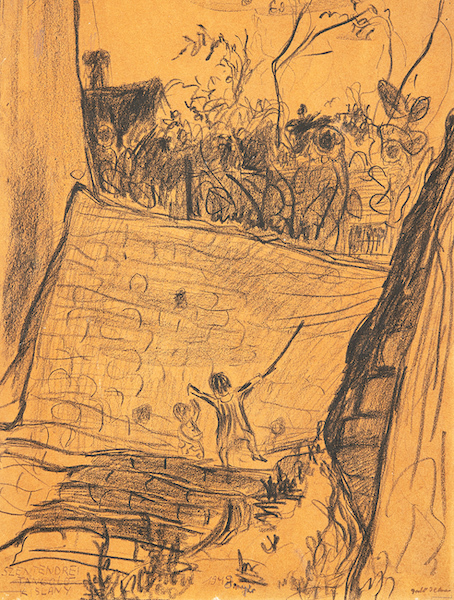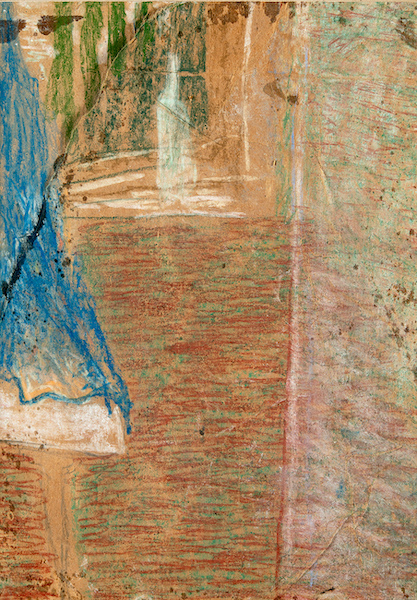Biography
She started drawing at the age of eleven, and most of her notebooks have survived. In 1939 she attended the free school of Tibor Gallé for a few months, and between 1939 and 1942 she was a private student of Viktor Erdei; in 1942-1943 she participated in exhibitions of the Hungarian Israelite Public Cultural Association (OMIKE) through the private school of István Örkényi Strasser. The Gedő family was forced into the ghetto in the summer of 1944. Fortunately, they survived the Holocaust by staying with their relatives (unlike Ilka's former teachers, Gallé, Erdei and Örkény Strasser, who all perished). On New Year's Eve 1945, she met Endre Bíró, her future husband, who introduced her to one of the most distinctive and exciting intellectual circles of post-war Budapest, the community of the Budapest Dialogical School. The two central figures of the society were Lajos Szabó and Béla Tábor. The participants sought to develop a distinctive syncretic system of theory, embracing and blending ideas from Abuddhism to a reestablished Marxism, from Kabbalah to Schopenhauer, from Christian mysticism to theosophy, and on to Freudism and the latest experience of contemporary natural sciences, and in which the visual arts played an exceptional role.
The three and a half years from the winter of 1945-1946 to the autumn of 1949 were the busiest and perhaps the most serious period of Ilka Gedő's life and career. She produced three series: the Ghetto Drawings (1945-1949), the Ganz Factory Series (1947-1948) and the Table Drawings (1947-1949). In the ghetto, she captured the everyday life of families forced to the margins of existence, the loneliness and vulnerability of children and old people in sensitive pencil drawings. Despite their small size, these works from the World War II era are as weighty as Henry Moore's air raid drawings. From 1947, her most important subject was herself. Her astonishingly large number of pencil and charcoal drawings, her pastels mark a decisive change: she seems to be putting on a mask, seeing herself as ageless with a corrosive masochism. The delicately woven lines of the earlier prints are replaced by sparser, longer, coarser, more ornamental-looking threads, and the depiction becomes tense and impetuous. These are life-threatening documents of a painful role-playing game, about the moral, mental and practical chances of 'being an artist', of living as an artist. Literature draws parallels with the self-portraits of Giacometti in the mid-fifties or Antonin Artaud in 1945. In Hungarian art, this type of self-portrait will not be matched for decades, and will only find an unintended echo in the works of János Major, later András Baranyay, and in other respects Tibor Hajas. During this period, a few relatively large drawings were also made which could have anticipated a kind of way out, a change. The subject was a table or stand that seemed out of proportion, a narrow table constantly in view. And because it was constantly in view, it gradually unfolded into the everyday wonder and metamorphosis of the spectacle. The objects on the table, the light falling on it, its own shadow - a thousand tiny modifications are made. The line on these sheets is never an outline, a delimitation, but always moving on, running in countless directions, releasing secret energies as soon as it starts - as if a summer sun had scratched its playful traces on the sheets of paper.
Endre Bálint writes that 'in 1949 Ilka Gedő stopped her artistic activity without any transition, and no one understood the reasons that created the crisis.'. A sixteen-year ghostly silence followed, which was broken after her first solo (studio) exhibition in Hungary in 1965, which Bálint organized for her. The first works of the resumption were the so-called "abstract portraits". In the circle of friends on Rottenbiller Street, she drew former members of the European School. During the years she had missed, it occurred to her several times that someone could be characterised in their entirety by their posture, their gaze, a single movement. Almost without exception, she painted from "archetypes". The "archetype" she chose - in fact a first sketch of her sudden ideas scribbled on small sketches - was enlarged to scale and reproduced on canvas without the slightest alteration. In the final picture, she painted not only the subject sketched on the paper, but all the elements of the archetype as motifs of equal importance: the torn or punched edges of the paper, the grid of lines on them, the instructions written on them. The archetype is the name, if you like, of the pictorial idea, a memoriter, capable of evoking the fleeting, flickering vision that originally imprinted itself, of which it is itself only a fragment, a subdivision. She worked on several pictures in parallel, and this is perhaps one reason why the genesis of each picture is recorded in a diary associated with that picture: the artist records for herself all her speculations about the composition of the picture. When she put a picture aside, she would also put away the diary for a while, and when she took out an unfinished picture, she would read through her notes from earlier in the process. Ilka Gedő was very familiar with the effects of colour and colour effects. The mixing of colours was not done at random, but by picking out a particular hue. Colour variations of a basic colour painted on a cardboard sheet were placed in separate boxes. For Gedő, colours were acts and sufferers of light (Goethe), not merely material beings but also spiritual ones, living beings (Cézanne) with which she could interact.
In 1969-1970, she worked in Paris, and two of her paintings were included in a collective exhibition at the Galerie Lambert. In 1980, she had a retrospective exhibition at the Szent István Király Museum in Székesfehérvár, followed by another exhibition in her home country in 1982 at the Dorottya Street Gallery in Budapest. In the late 1980s, she had several exhibitions in Glasgow (1987, 1989), and in the 1990s in New York (1994, 1996, 1997). In Hungary, her life-work exhibition was held in 1987 at the Műcsarnok and in late 2004 at the Hungarian National Gallery. Her works can be found in the collections of the British Museum, the Israel Museum, the Museum Kunstpalast in Düsseldorf, the Kupferstichkabinett in Berlin, the Albright-Knox Art Gallery in Buffalo and the graphic art collection of the Albertina in Vienna, among others. In 2016, twenty-one of her self-portraits were included in the collection of drawings at the Herzog Anton Ulrich Museum (HAUM) in Brunswick.


